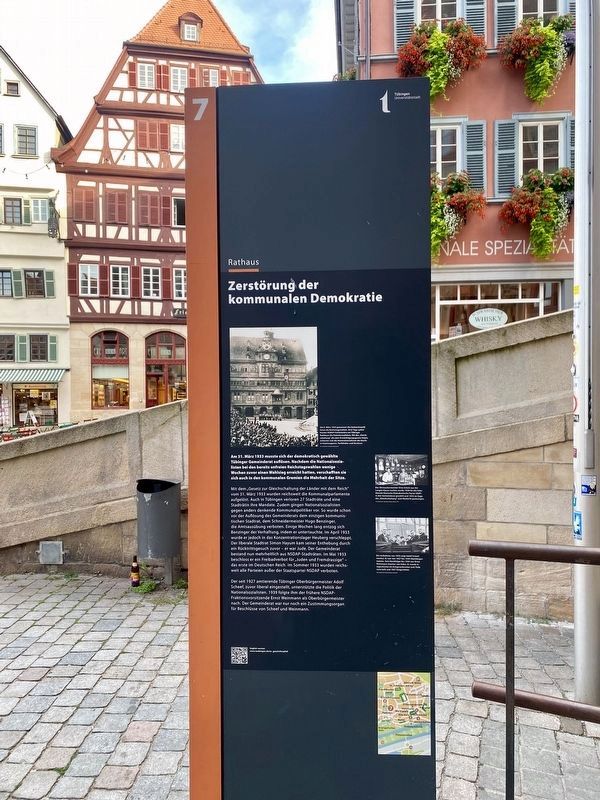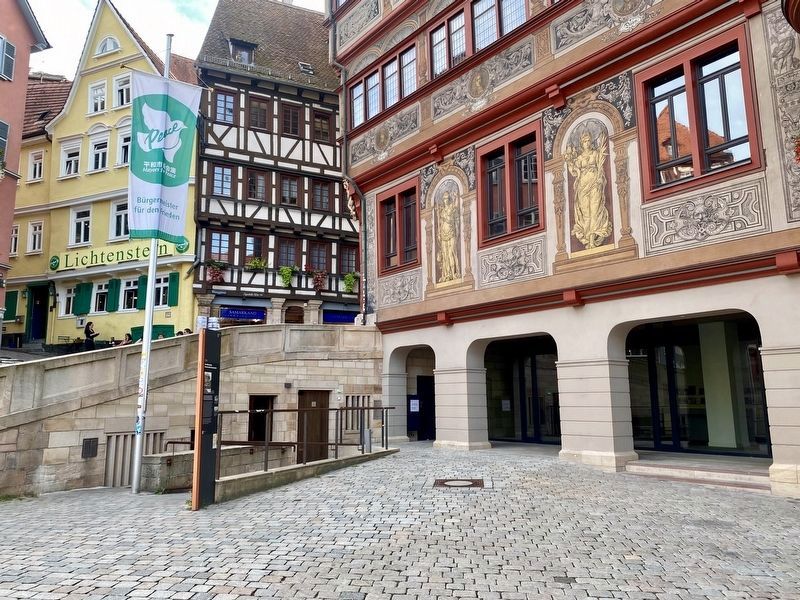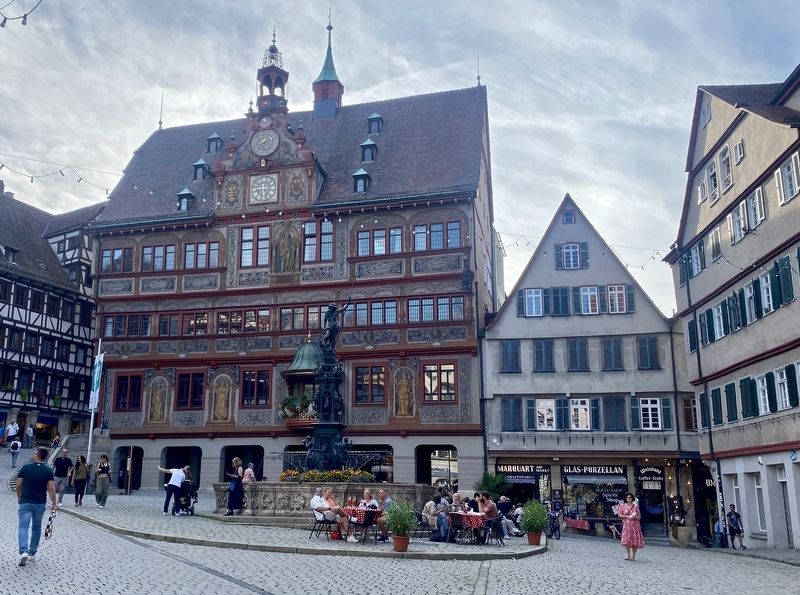Tübingen, Baden-Württemberg, Germany — Central Europe
Zerstörung der kommunalen Demokratie / Destroying the Municipal Democracy
— Geschichtspfad zum Nationalsozialismus —
Mit dem „Gesetz zur Gleichschaltung der Länder mit dem Reich“ vom 31. März 1933 wurden reichsweit die Kommunalparlamente aufgelöst. Auch in Tübingen verloren 27 Stadträte und eine Stadträtin ihre Mandate. Zudem gingen Nationalsozialisten gegen anders denkende Kommunalpolitiker vor. So wurde schon vor der Auflösung des Gemeinderats dem einzigen kommunistischen Stadtrat, dem Schneidermeister Hugo Benzinger, die Amtsausübung verboten. Einige Wochen lang entzog sich Benzinger der Verhaftung, indem er untertauchte. Im April 1933 wurde er jedoch in das Konzentrationslager Heuberg verschleppt. Der liberale Stadtrat Simon Hayum kam seiner Enthebung durch ein Rücktrittsgesuch zuvor – er war Jude. Der Gemeinderat bestand nun mehrheitlich aus NSDAP-Stadträten. Im Mai 1933 beschloss er ein Freibadverbot für „Juden und Fremdrassige“ – das erste im Deutschen Reich. Im Sommer 1933 wurden reichsweit alle Parteien außer der Staatspartei NSDAP verboten.
Der seit 1927 amtierende Tübinger Oberbürgermeister Adolf Scheef, zuvor liberal eingestellt, unterstützte die Politik der Nationalsozialisten. 1939 folgte ihm der frühere NSDAP-Fraktionsvorsitzende Ernst Weinmann als Oberbürgermeister nach. Der Gemeinderat war nur noch ein Zustimmungsorgan für Beschlüsse von Scheef und Weinmann.
On March 31, 1933, the democratically elected Tübingen Gemeinderat (town council) had to dissolve. After the Nazis had gained a victory in the (already unfree) Reichstag parliamentary elections a few weeks earlier, they also procured a majority of seats in Tübingen's municipal committees.
The "Gesetz zur Gleichschaltung der Länder mit dem Reich" (literally: "Law for the Coordination of the States with the Reich"; Gleichschaltung is best translated as "forced coordination") of March 31, 1933 dissolved municipal parliaments throughout the Reich. In Tübingen, 27 municipal councilmen and 1 councilwoman lost their mandates. In addition, the Nazis started to take action against different-minded local politicians. Already a few weeks before the municipal council was dissolved, the only Communist councilman, master tailor Hugo Benzinger, was prohibited from exercising
his office. Benzinger was able to prevent arrest for some weeks by going into hiding, but in April 1933, he was taken to Heuberg concentration camp in the Swabian Jura. Liberal councilman Simon Hayum, a Jew, forestalled his divestiture by offering his resignation. The municipal council was now majorly made up of councilmen from the Nationalsozialistische Deutsche Arbeiterpartei (National Socialist German Workers' Party, NSDAP). In May 1933 the municipal council decreed that "Jews and Foreign Races" were banned from frequenting public outdoor swimming pools — the first ban of this sort in the German Reich. In summer 1933, all parties in the Reich except the NSDAP were outlawed.
Oberbürgermeister (mayor) Adolf Scheef, in office since 1927 and formerly a liberal, supported National Socialist policies. In 1939, he was succeed by former Tübingen NSDAP party chairman Ernst Weinmann. The local council had been reduced to a mere tool of approval for decisions by Scheef and Weinmann.
Erected 2016 by Geschichtswerkstatt Tübingen. (Marker Number 7.)
Topics. This historical marker is listed in this topic list: Government & Politics. A significant historical date for this entry is March 31, 1933.
Location. 48° 31.218′ N, 9° 3.205′ E. Marker is in Tübingen, Baden-Württemberg. Marker is on Am Markt, on
the left when traveling north. Touch for map. Marker is at or near this postal address: Am Markt 1/1, Tübingen BW 72070, Germany. Touch for directions.
Other nearby markers. At least 8 other markers are within walking distance of this marker. Hermann Kurz (within shouting distance of this marker); Kornhaus (about 90 meters away, measured in a direct line); Ein Schöpfbrunnen aus der Unterstadt / A Well from the Lower Part of Town (about 120 meters away); Former Dominican Building (about 120 meters away); Regina Burckhardt-Bardili and Andreas Burckhardt (about 150 meters away); Martinianum: Keimzelle der Schwäbischen Romantik / Nucleus of Swabian Romanticism (about 150 meters away); Philipp Melanchthon (about 150 meters away); Polizei und Verfolgung unter Nationalsozialismus / Police and Persecution under National Socialism (about 180 meters away). Touch for a list and map of all markers in Tübingen.
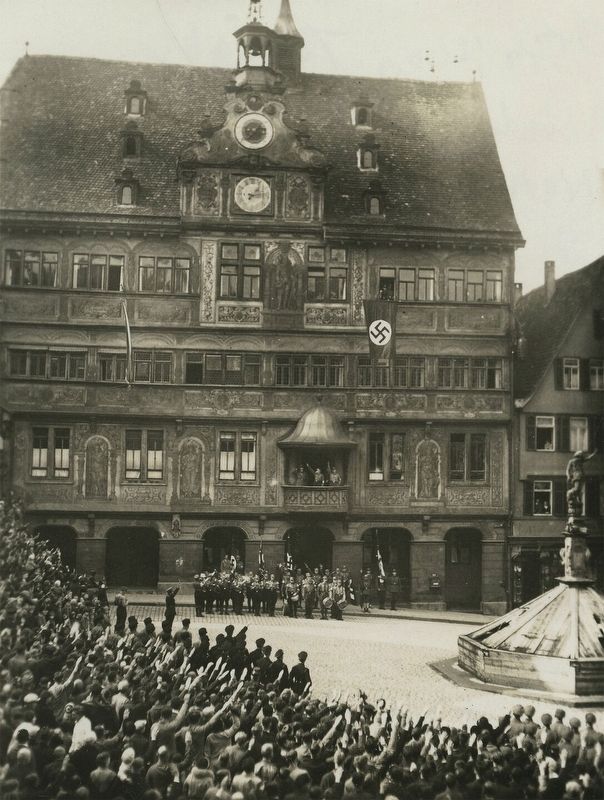
Hugo Kocher / City Archives Tübingen, circa 1933
4. Marker inset: Swastika Flag on City Hall
"On March 6, 1933, the National Socialists won the Reichstag parliamentary election. Three days later, they raised the swastika flag on the Tübingen Rathaus (city hall). The "Gleichschaltung" (forced coordination) following the Ermächtigungsgesetz (Enabling Act) secured National Socialist power in government agencies, associations, and Vereine (registered societies). "
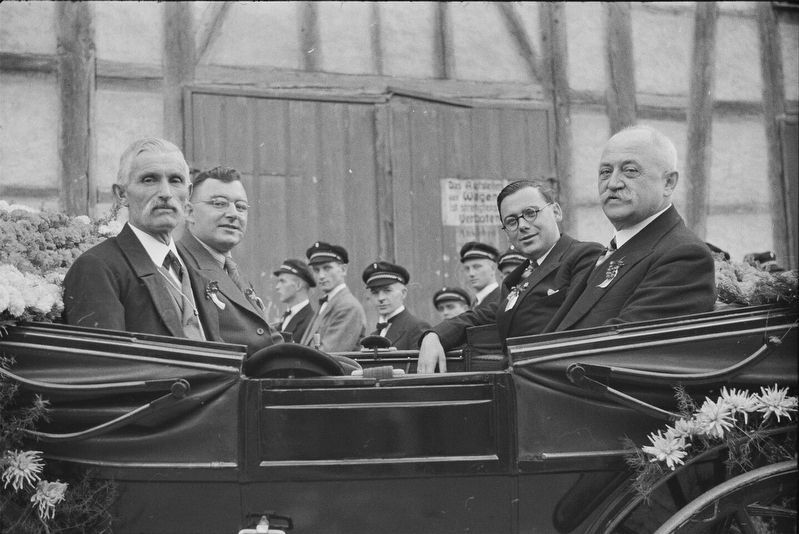
Hugo Kocher / City Archives Tübingen, 1935
5. Marker inset: former Nazi mayors
"Adolf Scheef (on the right), Oberbürgermeister (mayor) from 1927 to 1939, in 1935. Second to the left is Ernst Weinmann, Scheef's successor from 1939 to 1945. Weinmann, a war criminal, was sentenced to death and executed in Yugoslavia in 1947."
Credits. This page was last revised on October 17, 2022. It was originally submitted on October 17, 2022, by Andrew Ruppenstein of Lamorinda, California. This page has been viewed 44 times since then and 13 times this year. Photos: 1, 2, 3, 4, 5. submitted on October 17, 2022, by Andrew Ruppenstein of Lamorinda, California.
